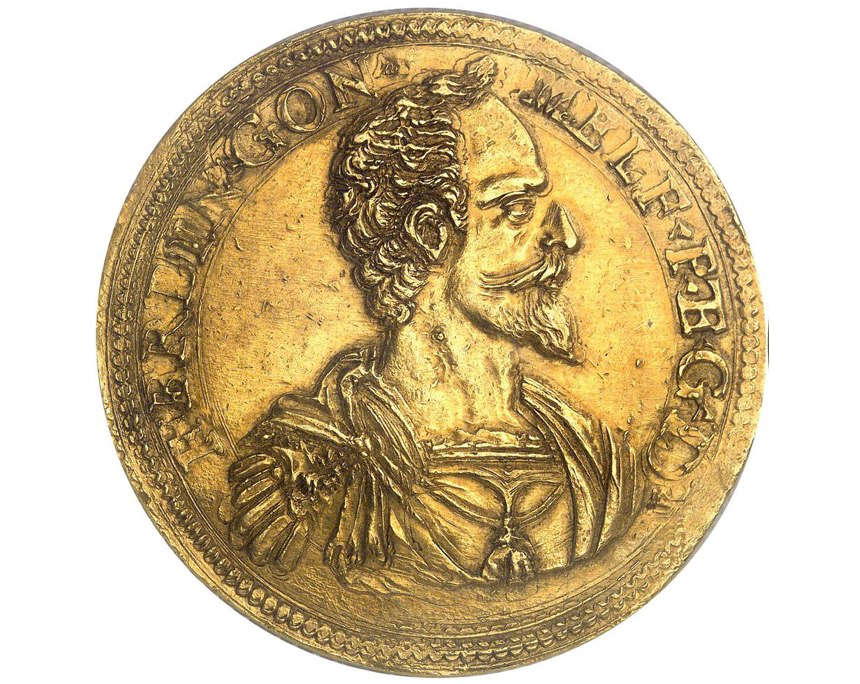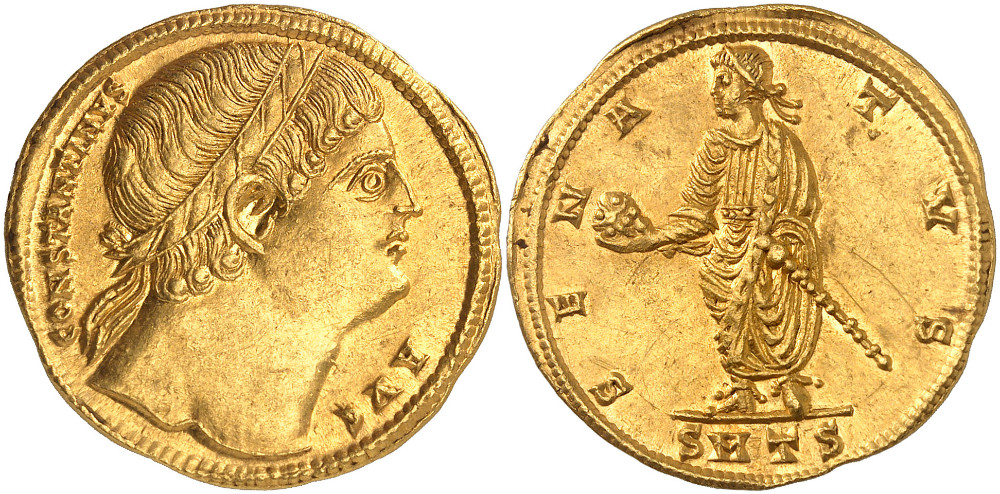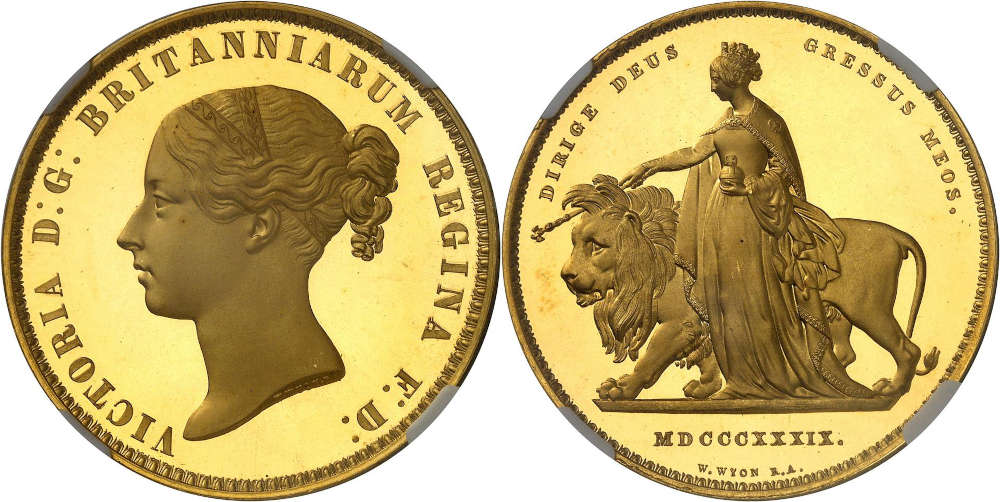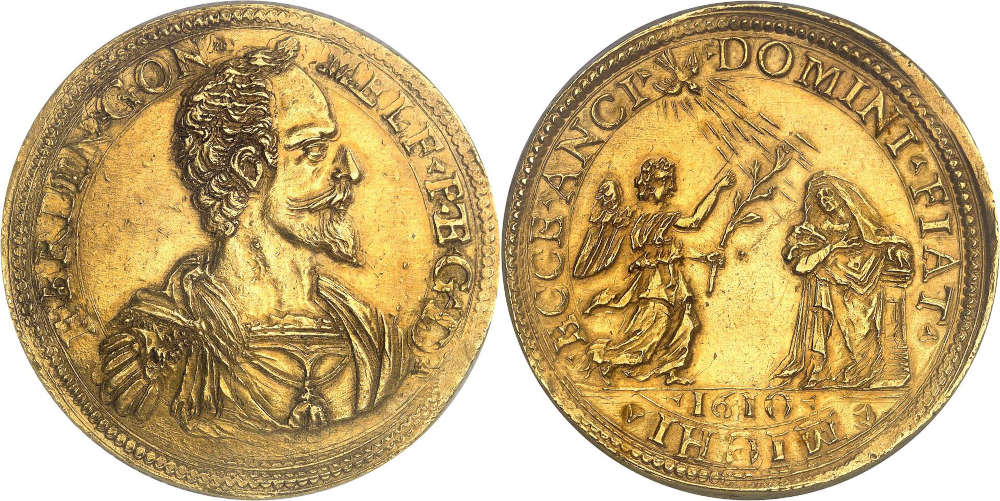MDC Presents Four Exceptional Collections
MDC Monaco
Auction 15
Coins
23-24 October 2024
MC-Monaco
MDC Monaco announced their 15th Numismatic Auction. The sale will take place on the 23rd and 24th of October 2024. The auction house presents, on this occasion, and among French and world coins, four exceptional collections. The Stephane Gouffault Collection, the Nicolas Maier Collection, the second part of The Collection of an American Gentleman (also known as “The French Collection”), and the X Collection, selection of barbarian coins.
- First session, Wednesday, 23 October – 9am – 12:30am – Lots n°1 to n°431
- Second session, Wednesday, 23 October – 1:30pm – 7pm – Lots n°432 to n°1137
- Third session, Thursday, 24 October – 9:30am – 12:15am – Lots n°1138 to n° 1446
- Fourth session, Thursday, 24 October – 1:30pm – 7pm – Lots 1447 to n°2200
The French Collection
After the incredible French coins collection auctioned in October 2023 by MDC Monaco (Auction n°12: The French Collection), the auction house offers this time an exceptional collection of German Double Thaler, and Thaler from Bavaria. All coins are of exceptional quality, with many high grades.
Stéphane Gouffault Collection
This collection is composed of one type each of monetary gold coins from the 19th Century, in the highest grades possible. A lot of coins are Top Pop, including a series of silver 5 Francs from the 19th Century. There is also a superb selection of royal coins from Louis the 13th to Louis the 16th, in the highest grades possible.
Nicolas Maier Collection
The collection is composed of 247 medals, French for the vast majority. Nicolas Maier is the author of the book L’Art de la Médaille en France, 1870-1940 (The Art of the Medal in France), and most of the coins presented in this auction are plate coins from this book.
Collection X, barbarian coins
The collection is composed of a very beautiful selection of barbarian coins.
Some Highlights
Lot 15
Ancient Greece. Sicily, Syracuse, Agathocles (317-289 BC). 50 litrai or gold decadrachm ND (317-310 BC), Syracuse. Obv. Laureate head of Apollo facing left, Σ behind the neck. Rev. ΣΥΡΑ-Κ-ΟΣΙΩΝ. Biga (two-horse chariot) driven by an auriga, galloping to the right; below, a triskelion. Dewing 934 v. – Gulbenkian 327 v. – SNG ANS 552 v. (left oriented triskelion); Gold – 4,27g – 16 mm – 12h. From Cincinnati Museum of Art, acquired by Harlan J. Berk in 1989, then in a private collection in Cincinnati, Ohio, Gemini V sale, January 6th 2009, n°42. NGC MS 5/5 4/5 Fine style brushed. With a right oriented triskelion. Minor traces of handling and hairlines for this very fresh example, with mint lustre barely burnished. Starting price: 10,000€
Agathocles takes power in Syracuse in 317, helped by a band of mercenaries. He orders the execution of some oligarchs of Syracuse and strengthens his power to control the whole Sicily. After having eliminated the Carthaginians, against whom he’s the first to start a military expedition in North Africa, he proclaims himself King (basileus) of Sicily in 306. Considering himself the successor of Alexander, he secures some alliances with the other Hellenistic rulers: for example, he marries the daughter of Ptolemy and he marries his own daughter to Pyrrhus I of Epirus. During his reign, he’s responsible for the trade in the western Mediterranean. After his assassination in 289, Sicily faces twenty years of political chaos until the arrival of Hieron. His reign is, for the arts, the period between the late classical style and the novelties of the Hellenistic style. Our example is a high level illustration of this art and a reminder that Apollo and his sister Artemis are protective deities of Syracuse.
Lot 150
Roman Empire. Hadrian (117-138). Aureus 134-138, Rome. Obv. HADRIANVS – AVG COS III P P. Draped and cuirassed bust, facing right. Rev. The River-god Nile, lied down facing left and leaning on a sphinx, holding a cornucopia, between a crocodile and a hippopotamus. Calicó 1159 – RIC.– (cf. 312); Gold – 7,31g – 19,5 mm – 6h. With a label indicating it was purchased from Vinchon, approximatively in 1975-1980. NGC Ch XF* 5/5 5/5 Fine style. Barely off-centered strike on the reverse. Very nice style, with an expressive bust. Very little wear and with the fields barely burnished by a thin patina. Rare. Starting price: 40,000€
Lot 185
Roman Empire. Constantine I (307-337). Multiple of 2 solidi, Imperial stay and vicennalia (20th anniversary of reign) ND (c.326), Thessalonica. Obv. CONSTANTINVS – AVG. Head of the Emperor wearing a headband, facing right. Rev. SENA-TVS. The Emperor, standing facing left, with a diadem, a toga, holding a scepter in his left hand and a globe in his right hand; below (mint) RIC.– (cf. 272 = Depeyrot p.153 (Rome, 4 1⁄2 solidi); Gold – 8,72g – 26,3 mm – 6h. From a Tkalec sale, in 1998, from a banker’s collection, then Numismatica Ars Classica 88, October 8th 2015, n°499 and Numismatica Ars Classica 111, September 24th 2018, n°225 Well struck on a wide flan. Few traces of manipulation with minimal hairlines on the fields. The mint lustre is barely burnished, with a very pleasant golden patina. Spectacular, with a magnificent bust. This is the only known example! Starting price: 200,000€
In 326, Constantine I The Great shares the consulate with Constantius II, his second son whom he had with Fausta, who was already Caesar since November 324 and the defeat of Licinius I. The Codex Theodosianus indicates that Constantine is present at Heraclea on February 3rd and March 5th, then at Constantinople on march 8th. From Constantinople, he probably stopped in Thessalonica before continuing to the west, arriving in Aquileia at the beginning of april to inaugurate a stay in Italy that will last almost eight months. There, Constantine attended some celebrations of his 20th anniversary of reign as well as the 10th birthdays of his two eldest sons, Crispus and Constantine II. This medallion could have been distributed at the beginning of april 326 in Thessalonica. 326 is also the year of Constantine’s conversion. According to Zosimus, he was overcome with remorse after having killed his eldest son Crispus, son of Minervina, his first spouse or concubine, as well as his nephew, Licinius Junior. His second wife Fausta dies under tragic circumstances locked in overheated baths, in 326 or 329. According to Zosimus, Constantine abandons the ancient religion for Christianity “which includes the promise that the infidels that converts to it are immediately cleanse of all crime”.
Lot 274
Germany. Bavaria, Maximilian I, Duke then Prince-elector (1597-1651). 5 ducats, New fortifications of Munich, with date in legend 1640, Munich. Obv. MAXIMIL: COM: PAL: RH: VT: BA: DVX: S: R: I: ARCHIDAP: ET. ELECT:. In an interior, the Duke, standing facing right, cuirassed and holding a stick in his right hand, his left hand laying on a cruciform globe placed on an altar. Rev. NISI. DOM: CVSTODIERIT. CIVIT. FRVST: VIGIL: QVI. CVSTODIT. (date) [Psalms 127:1]. Munich view, with its fortifications. In the sky, on clouds, the Virgin Mary with her child Jesus, between two cherubs. KM.268 – Fr.196; Gold – 17,36g – 38 mm – 12h. NGC MS62. With traces of the dies polishing clearly visible on the obverse and reverse. Very nice golden patina and a wide flan. Minor circulation wear without any major flaw. Starting price: 40,000€
Maximilian I is Count palatine of the Rhine, Duke of Upper and Lower Bavaria and Prince- elector of the Holy Roman Empire of the German Nation; those titles are mentioned on the obverse of our example. After being invaded by the Swedes during the Thirty Years’ War, the Duke fortifies his capital and residence when the peace comes. In 1648, the Treaty of Westphalia confirms the peace, the electoral dignity of the Prince and the Upper Palatinate remains in Bavaria.
Lot 693
France / Capetians. Naples, Louis XII (1501-1504). Gold Ducat ND (1501-1504), Naples. Obv. LVDO° FRAN° REGNIQ NEAP° R. Bust of the King facing right, wearing a crown laying on a hood. Rev. + PERDAM: BABILLONIS: NOMEN°. Crowned French shield. Dy.716 – MIR.111 – Bernareggi 196 – Fr.826; Gold – 3,51g – 23 mm – 3h. Top Pop: this is the only graded example! PCGS MS62. Very rare and important coin with a realistic effigy of the King, showing the future influence of the Italian Renaissance on French coinage. A very high quality strike on the obverse, barely showing a double strike, on a large flan and well-centered. Some mint lustre is still present under a thin patina. Starting price: 70,000€
Louis XII, heir to the Valois, has claims on the Duchy of Milan, by his grandmother Valentine Visconti, but also on Naples. He wins Milan after the Second Italian War (1499-1500) and some preparations are made to conquer Naples : support from the Pope Alexander XI Borgia and the Treaty of Granada, signed with Ferdinand II of Aragon. In 1501, Naples is attacked by French and Spanish and has to capitulate. When Jules II arrives in 1503, alliances change. The Aragonese win against the French troops at several occasions in 1504 and Naples is lost to Ferdinand VII of Aragon, confirmed by the Treaty of Blois (1504).
Lot 761
France / Capetians. Louis XIII (1610-1643). Ten gold Louis pattern, laureate head and draped bust 1640, A, Paris. Obv. LVDOVICVS. XIII. D. G. FRANC. ET. NAV. REX. Laureate and draped bust of the King, facing right, bellow (date). Rev. CHRISTVS. REGNAT. VINCIT. ET. IMPERAT. Cross composed by 8 Ls, each arm crowned, with A in a circle at the center, confined by four lilies diverging from the center. Dy.1293 – G.63 – Drs (1987) PP2 – Kind BnF 1467 (TL) and 1468 (TC) – Fr.405; Gold – 67,18g – 48 mm – 6h. NGC AU DETAILS CLEANED. Tiny old cleaning with some scratches on the obverse. Regular and homogeneous wear. The fields are burnished by little manipulation marks, with a golden patina. Very rare. Starting price: 250,000€
The making of Gold multiples to the modules of 8 or 10 Louis by Jean Warin is known by two documents from the National Archives, published and analyzed by Fernand Arbez and Christian Charlet, Une médaille d’or de 100 livres, à l’effigie de Louis XIII, volée et restituée à Jean Warin en 1641, BSFN, march 2014, p.66-70. The gold multiples of 54 grams or 67.5 grams are described as 8 and 10 gold Louis coins since 1878 and the work of Hoffmann. This denomination has been taken over by Ciani in 1926, Duplessy in 1989 and 1999, Droulers in various editions, etc. However, F. Leblanc in 1690 describes those coins as pleasure coins. More recently, for J. Lafaurie and P. Prieur, in the third unpublished volume of their work, Les Monnaies des Rois de France, those examples are patterns of non-chosen types. The documents from the archives published by Arbez and Charlet confirm the date of those patterns engraved by Jean Warin in 1640. Nevertheless, those monetiform patterns didn’t have any legal value. We choose the denomination 8 (or 10) Gold Louis pattern.
Lot 1240
France. Second Empire / Napoleon III (1852-1870). Gold pattern of 100 francs bare head, Proof, smooth edge, A under the bust, 1855, A, Paris. Obv. NAPOLEON III EMPEREUR. Bare head facing right, below (mint) and signature BARRE. Rev. EMPIRE FRANÇAIS. Imperial coat of arms set on a crowned mantle and over the scepter and the hand of justice, 100 and FRs on the sides; below (different) (date) (different). Maz.1600 – G.1135 p.583 = this example! – VG.–; Gold – 32,25g – 35 mm – 6h. Top Pop : this is the only graded example ! From the Farouk Collection, king of Egypt, Sotheby’ sale February 1954, n°575 then Heritage sale 3033, Chicago, august 8th 2014, n°23223. NGC PF65 CAMEO. Proof with mirror fields looking glazed and matte reliefs, with full mint lustre, creating a Cameo contrast. Very rare. Remarkable pedigree. Starting price: 200,000€
Lot 1272
France. Second Empire / Napoleon III (1852-1870). Gold pattern of 100 francs laureate head, Specimen (SP) 1862, E, Paris. Obv. NAPOLEON III – EMPEREUR. Laureate head facing right, below (mint) and signature BARRE. Rev. EMPIRE FRANÇAIS. Imperial coat of arms set on a crowned mantle and over the scepter and the hand of justice, 100 and FRs on the sides; below (anchor) (date) (anchor). G.1136 – Maz.1603 – VG.3613; Gold – 35 mm – 6h. This is the second highest grade! Only a SP67 example, MDC sale 9 n°735 (440 000€+fees) is in higher grade. PCGS SP65CAM. Specimen with smooth edge and date between two anchors on the reverse. Mirror glazed fields and sandy reliefs give a Cameo aspect. Only some minor fingerprints on the obverse. Exceptional presentation quality, in its mint state, with a golden patina with barely greenish tones. Very rare. Starting price: 200,000€
Lot 1767
Great Britain. William IV (1830-1837). Crown, gold strike, Proof 1831, London. Obv. GULIELMUS IIII D: G: BRITANNIAR: REX F: D:. Bust facing right, signature W. W. on the edge of the neck. Rev. Shield surrounded by the Collar and laying on a crowned mantle; below ANNO (date). KM.PnA98 – Esc.2463 (R5, previously. Esc.272) – S.3833 – Fr.381; Gold – 38 mm – 6h. Top Pop: this is the only PCGS graded example! PCGS PR62DCAM. Proof with smooth edge and a Deep Cameo effect between mirror fields and matte reliefs. Minimal notches on the rim, minor hairlines on the fields and some micro-scratches. Very nice light, golden patina with barely greenish tones. Very rare. Starting price: 300,000€
The bust, on the obverse, is inspired by Francis Leggatt Chantrey (1782-1841), a renowned sculptor during the Georgian era, famous for his busts. The reverse is made by Jean-Baptiste Merlen (1769-1850), who was an engraver and medalist in Paris before moving to London after the Battle of Waterloo. He joins the Royal Mint in 1820, recommended by Benedetto Pistrucci, as assistant engraver to the chief engraver William Wyon. Merlen mainly worked on reverses, such as the ones used on the half-sovereigns of William IV, a theme that will be taken up again under Victoria, or the reverses of the Maundy set coins, used from 1822 to 1887.
Lot 1773
Great Britain. Victoria (1837-1901). 5 pounds “Una and the lion”, headband with 5 rolls and 9 leaves, Proof 1839, London. Obv. VICTORIA D: G: BRITANNIARUM REGINA F: D:. Bust facing left, wearing headband; signature W. WYON R. A. Rev. DIRIGE DEUS – GRESSUS MEOS. The queen facing left leading a lion with her sceptre: below (date) and signature W. WYON R. A. Fr.386 – S.3851 – W&R.279 – GH.103; Gold – 37 mm – 12h. Top Pop: this is the higher graded example ! For this variety (headband with 5 rolls and 9 leaves), our example is the higher graded by NGC amongst 41 proof examples [The top pop example graded PF is 63; the top PFCA is 63; the top PFUC is 66 (our example) and the second highest in PFUC is far behind, graded 64*] NGC PF66* ULTRA CAMEO. Proof and Ultra Cameo. Raised letter edge: DECUS ET TUTAMEN * ANNO REGNI TERTIO*. In its mint state with minor micro-scratches on the glazed fields. Intact mint lustre. Starting price: 700,000€
Conceived by William Wyon (1795-1851) in 1839 to commemorate the beginning of queen Victoria’s reign (1837), the “Una and the lion” 5 pounds is considered one of the most beautiful British coins. Victoria, standing with a lion, is moving left, with the motto “May God directs my steps” above her. The young queen, 20 years old, is represented as Lady Una, from Edmund Spencer’s The Faerie Queene, a poem written in 1590. This is the first time a British monarch is represented as a fictitious character: England as a lion is guided by Una, personified by queen Victoria, and her sceptre.
Lot 1787
Great Britain. Victoria (1837-1901). Pattern of 5 international francs or Double florin, smooth edge, by William Wyon, Proof 1868, London. Obv. VICTORIA D: G: BRITANNIAR: REG: F: D:. Crowned bust facing left. Rev. 5 FRANCS / INTERNATIONAL. In a two oak branches crown : DOUBLE FLORIN (date). W&R.372 (R4) – KM.Pn115; Gold – 1,52g – 16 mm – 12h. NGC PF64 ULTRA CAMEO. Proof: the mate mint lustre on the reliefs is barely touched and mirror fields only show some fingerprints. Less than 20 known examples. Starting price: 15,000€
In 1867, under the reign of Napoleon III, France seeks to create a universal currency based on the Germinal franc. The Universal Exposition attracts 7 million visitors from all around the world. In the same time, the Ministry of Foreign Affairs hosts an international monetary conference with European countries, including Russia and the Ottoman Empire, and the United States of America. In 1865, the Second Empire already succeeded in establishing the Latin Union between France, Belgium, Switzerland and Italy. After 2 months of discussions, the project is abandoned but a theoretical agreement is reached on some points : the gold standard (the silver is abandoned) ; the fineness of 9/10th and the unified weights ; the decimal system (the duodecimal system is abandoned) ; common monetary unit. In France, a 25 gold francs coin is desired, a coin close to the American 5 dollars, the USA being the first country to have a decimal system in the world, but also close to the British sovereign and to the 10 Dutch forints. 1868 should have been the year of realization for the project but it has to face lack of political consensus and then the shift to protectionist blocs. For Great Britain, this double florin or 5 francs project is the work of William Wyon; he took special care of this strike, intent to impress internationally.
Lot 1872
Italy. Guastalla (county then duchy), Ferdinand II Gonzaga (1575-1630). 10 doppie 1610, Guastalla. Obv. FERDIN. GON. – MELF. P. TE. G. D. [Ferdinand Gonzaga, Prince of Melfi and Lord of Guastalla]. Draped and cuirassed bust, with the golden Feece, standing three-quarters facing right. Rev. ECCE. ANCI. – DOMINI. FIAT. – MICHI. Annunciation scene ; below (date).MIR.353 – CNI.IX.17 and 19 – Bellesia 8 – Fr.458 = this example ; Gold – 66,35g – 46 mm – 6h. Top Pop: this is the only graded example ! From The Paramount collection, n°30364. This example is illustrated in Friedberg, 9th edition, p.555. NGC MS61. Only 4 examples seem to be known, including 3 in public collections (Milan and CNI)! Big module strike, well struck, barely off centered with a minor double strike. Spectacular bust on the obverse and very nice Annunciation scene on the reverse. Beautiful golden reflections. An unique opportunity to acquire a museum piece! Starting price: 400,000€
Ferdinand II Gonzaga (or Ferrante II Gonzaga), Lord and Count of Guastalla, is the son of Caesar I of Guastalla and Camilla Borromeo. In 1621, his county became a duchy. He is married to Giovanni Andrea Doria, coming from the family of great Genoese admirals.
Lot 1899
Italy. Savoy, Victor Amadeus II (1675-1730). Gold medal, module of 20 ducats, Capture of the city of Cremona by Prince Eugene of Savoy and capture of the Marshal Villeroy, by P. Müller, Specimen (SP) 1702, Augsburg. Obv. PATIENS VOCARI – CÆSARIS VLTOR [Horace, Odes, “Allow yourself to be called the Caesar’s avenger”] To the left, Pheme holds a medallion with a cuirassed effigy facing right of Prince Eugene, surrounded by palms, and circular legend: EUGEN: PR: SAB: CÆS: EX: GENER: COMD. Under the medallion, an eagle is holding a rooster between its talons and some chickens are fleeing. Below: VILLAREGIO SVPR. GALL/ DVCE INTRA MOENIA/ CREMONÆ CAPTO/ 1702 [Villeroy, Marshal of France, captured in Cremona]. Rev. FLANTIBVS AVSTRIS. Allegory of the Holy Roman Empire, as Athena, seating with spear and shield, holding a Victory while the wind is destroying lilies fields. Below: VIRTVS GERMA/ NORVM. VL.IV p.370 – Coll. Julius cf. 627 – Montenuevo cf. 1166; Gold – 69,13g – 40,5 mm – 12h. Top Pop: this is the only graded example ! PCGS SP61. Raised letter edge: : + FLORENTES FERVLAS ET GRANDIA LILIA QVASSANS [He tears down the flowering rods and the highest lilies]. Still has some mint lustre under a thin patina. Scratch on the leg of Pheme and minimal hairlines on the reverse’s fields. Probably unique! Starting price: 50,000€
By Philipp Heinrich Müller (1654-1719), one of the most famous European medalists from late 17th to early 18th century. Born in a modest family, Müller begins working for a goldsmith in Augsburg. Thanks to his talent, he’s spotted by Leonard Weiss, city councillor, who allows him to become a medal engraver. He is working for Augsburg, but also in Nuremberg for Caspar Gottlieb Laufer, Mint-master in Nuremberg. He becomes known and admired throughout Europe where he reproduces portraits of many Princes and rulers of his time.
Lot 2120
Switzerland. Helvetic Confederation (1848-present day). Pattern of 20 francs Vreneli, gold from Gondo’s mines, in Valais, with small cross, Specimen 1897, B, Bern. Obv. HELVETIA. Bust of Helvetica facing left; signature F. LANDRY. Rev. On two oak branches, shield of the Confederation with 20 and FR on the sides; below (date) and (mint). Fr.501 – HMZ.1195b – OC.405.1a; Gold – 21 mm – 6h. This is the third PCGS highest grade! PCGS SP64. Specimen. With small crosses. Struck with the gold extracted in Gondo, in Valais, with a characteristic greenish color. Only 29 struck examples! Almost in its mint state, with only some micro-scratches. Starting price: 200,000€
In 1291, year of the pact between Uri, Schwyz and Unterwalden, Gondo has been bought by the Bishop of Sion, Boniface de Challant, to the territory of Novara. Thanks to a post office linking Lyon to Milan, the main resource for the inhabitants of Gondo was trade with Italy. Some gold mines were exploited from the middle of the 16th century to the end of the 19th century. Gold exploitation was definitively abandoned in 1897. Only 29 coins of 20 francs were struck with the gold extracted in Gondo in 1897, last year of minting with that gold. Only a few examples are known : one in the Swissmint collection, without the cross ; one in the Museum of Zurich, with the cross ; finally, 2 or 3 examples sold in 2002, 2013 (NGC SP66) and our example.











